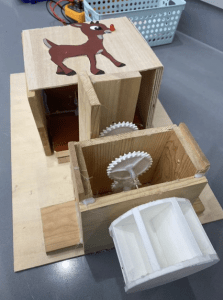
Introduction:
My project is a downscaled water turbine, capable of turning gravitational potential energy (water flow) into kinetic energy (when the turbine spins and causes the gears to spin) and finally into electrical energy (when the kinetic energy turns the dynamo, the dynamo generates electricity). It consists of three major areas, being the water setup, gearbox+turbine, and the dynamo setup.
Question 1: How does my product work? Does it work consistently?
The water turbine utilizes the magnetic fields within the dynamo motor to generate electricity, which can then be used to power a LED light. In order to power the turbine, a substantial amount of gravitational potential energy is needed, which in my case, would be the water out of a tap. My product works quite consistently, not needing any electrical power, as well as lasting a long time, due to the dynamo being quite sturdy. However, a flaw with my project is that the turbine could only power the light when turned clockwise, and not counterclockwise. As discovered, if we turned the turbine counter clockwise, the gearbox would break, as we used glue to attach the gears onto the axles, and once twisted vigorously in the other direction, the glue would eventually break.
Question 2: What was the high and lows of your project?
A high for me would be the productiveness of my group. My group was able to work on task and efficiently during the entire span of the project, which helped our project massively—as our project was rather hard to accomplish—. However, a low for my team would be the designing of the turbine, which required vigorous work and countless discussions, in order to weigh out the pros and cons of each design. However, our group managed to work through the hard tasks, and succeeded in the end.
Question 3: What would you improve next time?
For my product, the resistance (friction) in the steel axles and particularly in the dynamo was very high, which caused our product to not work with regular school taps (water source), and requiring more water pressure to turn the water turbine. If I were to attempt this project again, I would have paid more attention to the axles and joints in our product, as ball bearings could have massively helped in terms of reducing friction. As well as the gearbox, being more negative than positive, as it generated more torque at the exchange of more friction.
Question 4: How well did your group do?
Our group did decently well, as we only worked outside of class once, and only briefly. However, every rose has its thorns. As a result of the friction, we were only able to power the turbine via our hands (hand crank), as the school water had too less pressure, and resulted in the turbine not turning.
Question 5: What impacts does your product have on the real world?
If our product would be slightly improved (less friction and torque), our product could benefit many individuals globally. It is capable of harnessing the energy of gravity, and turning it into usable electrical energy. If our product was scaled up, perhaps it could generate massive amounts of electricity, which would benefit millions worldwide.
Leave a Reply
You must be logged in to post a comment.